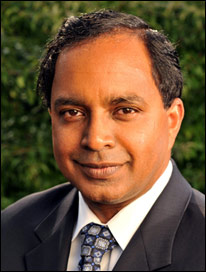 Kenneth Hansraj, MD, of New York Spine Surgery & Rehabilitation Medicine in Poughkeepsie, N.Y., discusses the need for patients to take responsibility for their health, rising healthcare costs and how the future of spine surgery has already arrived.
Kenneth Hansraj, MD, of New York Spine Surgery & Rehabilitation Medicine in Poughkeepsie, N.Y., discusses the need for patients to take responsibility for their health, rising healthcare costs and how the future of spine surgery has already arrived. Q: What are the biggest challenges you face in your day to day practice as a spine surgeon?
Dr. Kenneth Hansraj: Patients need comprehensive care — surgery is just part of the solution. When we operate, we typically decompress an area and perhaps stabilize that segment with screws, rods and bone graft.
Patients also need to take personal responsibility in optimizing their spines, therefore optimizing their lives. This will lead to better, long-lasting results from surgery.
Q: How do you think these challenges will evolve during the rest of the year?
KH: Americans are spending a significant amount of money to treat spinal problems. According to The Journal of the American Medical Association, spending on spine treatments in the U.S. totaled nearly $86 billion in 2005, a rise of 65 percent from 1997, after adjusting for inflation.
According to Dr. Matthew A. Davis at Dartmouth's Geisel School of Medicine, "basically each year the US Bureau of Labor statistics releases indices for the pricing of different services and goods (based on economic analyses, dollar value etc.). I used the index for medical services in 2005 (323.2) compared to 2011 (400.26). The difference therefore is the relative change in pricing due to inflation. To convert the 2005 dollars to 2011 equivalents you simply take $86 billion x (400.26/323.2) = $106.5 billion."
In 2013, per se, it may cost $110 billion to our beleaguered economy, in which spine surgery may be a $25 billion dollar cost. Americans need to take a personal stake in the maintenance of their health. When patients are healthier then the results of surgeries are better.
Q: How have the challenges of spine surgery changed from when you first began to practice?
KH: When I first started my practice, I faced the challenge of becoming a known surgeon, along with developing the daily and weekly routines to render the best services for my patients.
Today, I am challenged in being able to render my best care; including operating when necessary and helping patients to understand the core drivers that are important to their spinal and general health.
Q: How have you been addressing these obstacles?
KH: I have written two books for my patients, all of whom are part of the general public.
Keys to An Amazing Life: Secrets of the Cervical Spine was written with the everyday person in mind and consists of cutting-edge descriptions of every option that is available, cost-free. With four out of five people suffering from spinal health issues at some point in their life, globally, spinal problems are one of the most common reasons to visit a physician. Cost of care in the United States is approximately $110 billion a year. Intelligent people from all walks of life demand to know what makes up the spine, what problems could arise, and what lifestyle, conservative treatment, and surgical options are available.
Bloodless Spine Surgery: Pictures & Explanations is a picture book comprised of 150 images that was created to take a reader though safe spinal surgery. The basic medical evaluation with emphasis on medical, cardiac and blood concerns including algorithms of when to do cardiac stress tests, how to stimulate the body's own blood production with erythropoietin, along with surgical strategies, are explained.
Q: Will you continue you to take on these difficulties in the same way or will you have to change how you practice?
KH: I will continue to help patients to take responsibility for their personal and spinal health. My portion of care is to decompress areas that are compressing the spinal canal. From time to time stabilization of segments in the form of spinal fusion may be necessary to diminish pain and restore function.
Q: What do you think is the most important issue spine surgeons need to address?
KH: The most important issue that I find myself focusing on is "how can I best service my patient?" While we can do major operations, from time to time I am always considering if a small operation may help the patient return to work with better function. Sometimes less is more. My predominant goal is to return an improved client to the life force and the workforce.
Q: How do you think spine surgery will change in the future?
KH: The future is already here in spine surgery. Today, I believe we are able to do more precise, faster, bloodless and more effective surgeries. The support that we receive in the operating room is unprecedented. I counted one day that there were 18 computers monitoring various parts of my spinal surgery. Navigation-assisted placement of instrumentation is a huge improvement to my surgical practice. Instantaneous, intraoperative imaging services are continuously improving.
Operating room tables are far more modular, radiolucent and flexible. Operating instruments are also far more thoughtful than before. The bone scalpel, for example, is very precise and saves a lot of operative time and blood loss. Spinal instrumentation companies compete on providing easier to use tools with less steps involved in their placement. Bone graft options are ever expanding. Spinal cord and neuromonitoring makes these spinal operations safer.
More Articles on Spine:
6 Spine Surgeons on Healthcare Reform Challenges
8 Trends for Surgical Management of Lumbar Spinal Stenosis
35 Orthopedic & Spine Devices Receive FDA 510(k) Clearance


